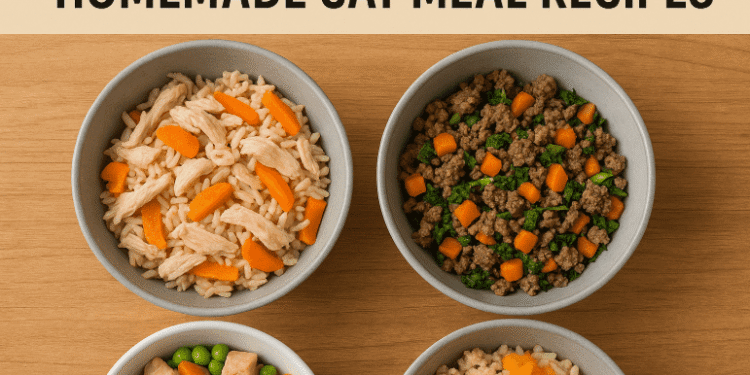Making homemade meals for your cat is a thoughtful way to provide them with high-quality, nutritious food. It gives you full control over what your cat is eating and ensures each ingredient is secure and wholesome.
Many commercial cat food choices contain additives, fillers, and fillers. Whereas they are helpful, they don’t continuously prioritize your cat’s health the way homemade meals can.
By using new ingredients and adjusted recipes, you’ll be able to offer dinners that improve your cats’ assimilation, energy levels, and coat health. Additionally, you can take inspiration from Smalls recipes, which are known for their real-food approach.
Always Consult a Vet First
Before changing your cat’s diet, speak with a veterinarian. Cats need specific nutrients like taurine, vitamin A, and omega-3 fatty acids.
A well-intended homemade meal can go wrong if essential elements are missing, so professional guidance is crucial.
1. Chicken & Pumpkin Delight
Why it’s great: This recipe is protein-rich and helps with digestion. Pumpkin is a natural source of fiber.
Ingredients
- 1 cup cooked, shredded chicken breast
- 2 tablespoons plain pumpkin puree
- 1 teaspoon olive oil
- Optional: a pinch of dried catnip
Instructions
Mix all ingredients in a bowl. Serve at room temperature. Store any leftovers in the fridge for up to two days.
This meal mirrors the simplicity and quality of many Smalls recipes, focusing on real meat and digestive-friendly add-ins.
2. Tuna & Quinoa Energy Bowl
Why it’s great: Tuna provides essential fatty acids, while quinoa is a healthy, gluten-free grain rich in protein.
Ingredients
- 1/2 cup canned tuna (in water, drained)
- 1 tablespoon cooked quinoa
- 1/2 mashed boiled egg
- Optional: a dash of fish oil
Instructions
Combine everything in a bowl. Serve immediately or refrigerate for up to two days.
Avoid feeding tuna too often, as overexposure may lead to mercury buildup. Use this meal occasionally for variety.
3. Turkey & Rice Comfort Stew
Why it’s great: This comforting dish is easy to digest and rich in lean protein and gentle carbs.
Ingredients
- 1/2 cup cooked ground turkey
- 2 tablespoons cooked brown rice
- 1 tablespoon cooked, chopped carrots
- 1/4 cup low-sodium chicken broth
Instructions
Warm all ingredients in a pot. Let it cool to room temperature before serving.
This recipe is simple, filling, and reflects the balanced, clean style found in premium cat food brands like Smalls.
4. Beef Liver & Sweet Potato Mash
Why it’s great: Liver is packed with essential vitamins like vitamin A and iron. Sweet potatoes provide fiber and antioxidants.
Ingredients
- 2 tablespoons cooked beef liver (finely chopped)
- 1 tablespoon mashed sweet potato
- 1/2 teaspoon flaxseed or fish oil
Instructions
Mash and mix ingredients. Let cool before serving.
Because the liver is nutrient-dense, serve it only once a week to avoid overfeeding on vitamin A.
5. Small-Inspired Salmon Medley
Why it’s great: This soft, moist meal is rich in omega-3s and mimics high-quality Smalls recipes.
Ingredients
- 1/2 cup cooked, flaked salmon (boneless)
- 1 tablespoon steamed, finely chopped green beans
- 1 tablespoon low-sodium bone broth
Instructions
Mix all ingredients and warm slightly. Serve at room temperature.
Salmon supports a healthy coat and immune system, making this a go-to treat for cats who enjoy seafood.
Storage and Feeding Tips
Always store leftovers in airtight containers in the refrigerator. Use within 3 days.
For convenience, freeze small portions in silicone molds. Thaw and serve at room temperature, never hot.
Final thoughts
Homemade meals can be a healthy and fulfilling elective to conventional cat food, particularly when they follow the quality-focused approach seen in Smalls recipes. Each supper you prepare helps your cat live a more advantageous, more lively life.
From chicken and pumpkin to salmon mixtures, your pet will adore the care and taste in each bowl. Start small, turn suppers, and continuously keep your cat’s dietary needs in mind. A cheerful, sound cat is the leading remunerator for your effort in the kitchen.
Faqs
Is Homemade Cat Food Better Than Store-bought Food?
Yes, handmade cat food can be superior in the event that it is prepared accurately. It allows you to utilize new, high-quality fixings without fillers or additives. Be that as it may, it must be nutritiously adjusted, so it’s imperative to allude to”>to allude to a vet some time recently, completely exchanging.
Can I Feed My Cat Chicken Every Day?
Feeding plain, cooked chicken sometimes is fine, but it shouldn’t be the protein source. Cats require a change to eat less, including other meats, fats, and supplements. Over time, a single-protein count of calories can lead to deficiencies.
What is Taurine, and Why Is It Important in Cat Food?
Taurine is an essential amino acid that cats cannot produce on their own. It underpins heart health, vision, and assimilation. All cat food, including handcrafted meals, must incorporate taurine, typically found in meat, particularly organ meats.
How Often Should I Feed My Cat Homemade Food?
Adult cats should be fed 23 times per day. If you switch to homemade meals, start slowly and monitor your cat’s weight and health. Parcel sizes depend on your cat’s age, weight, and activity level.
Can I Store Homemade Cat Food in the Fridge?
Yes. Store homemade cat suppers in waterproof holders within the refrigerator for up to 3 days. For longer storage, freeze portions and thaw as needed. Always serve food at room temperature, never cold or hot.



